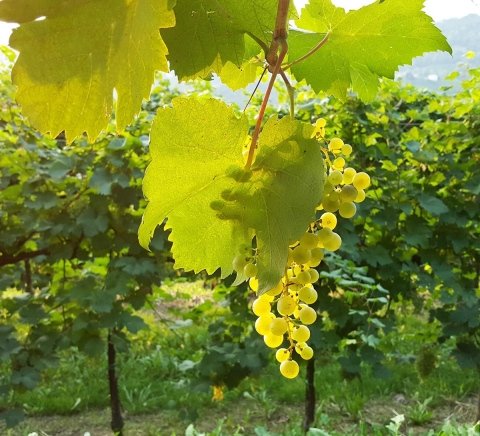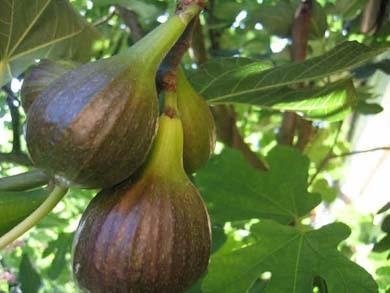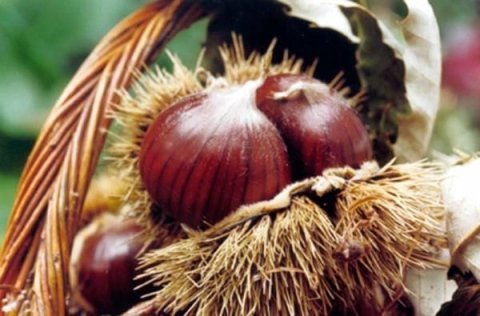

L'uva - The Grape
Un buon prodotto della terra è la sintesi di tante componenti che l’Azienda individua, sceglie e rispetta. Raccontarlo è complesso ma se penso che essa è il ringraziamento che la vite mi riserva per tante cure che le dedico, allora tutto è più semplice. La vite si esprime tramite la chioma ed i frutti. Quando è felice dà sempre il massimo di sé stessa, anche se talvolta in condizioni diverse e avverse. L’armonia che essa percepisce deriva anche dal nostro territorio in cui abbiamo voluto mantenere la biodiversità che le consente di vivere in un ambiente incontaminato. Ecco che i 4 tipi diversi di terreno colorano le foglie con varie sfumature; ecco che le sostanze ivi contenute stimolano o limitano la crescita della chioma determinando forma e colore dei bellissimi grappoli; ecco che l’orientamento e l’altezza variabile dei filari stimola le viti a riempire le bacche con essenze diverse creando una varietà infinita di profumi; ecco che le tecniche colturali sono finalizzate all’aiuto e alla preservazione di tutte le specie con uso di prodotti blandi e rispettosi.

A good product of the earth is the synthesis of many components that the company identifies, chooses and respects.
Telling it is complex but if I think that it is the thanks that the vine reserves me for the many care I dedicate to it, then everything is simpler.
The vine expresses itself through the foliage and the fruits.
When she is happy she always gives the best of herself, even if sometimes in different and adverse conditions. The harmony that it perceives also derives from our territory where we wanted to maintain biodiversity that allows it to live in an uncontaminated environment.
Here the 4 different types of soil color the leaves with various shades; here the substances contained therein stimulate or limit the growth of the foliage, determining the shape and color of the beautiful clusters; here the orientation and the variable height of the rows stimulate the vines to fill the berries with different essences, creating an infinite variety of aromas; here is that the cultivation techniques are aimed at helping and preserving all species with the use of bland and respectful products.

Il "figo longhet", di Tarzo
Il “figo longhet” di Tarzo ha ottenuto il riconoscimento di denominazione di origine protetta. Una vera prelibatezza. Si tratta di un prodotto che fa parte della nostra storia e delle nostre tradizioni. Da tempo immemorabile a Tarzo, lungo i pendii meno adatti alla semina, è diffusa la coltivazione del “Figo Moro”, chiamato appunto “Longhet”. Gli arbusti, non richiedono particolare cura e crescono nelle zone più impervie, dove risulterebbe difficile la coltivazione di altri alberi da frutto. Le radici, inoltre, vanno a rendere più solido un terreno altrimenti fragile. Peculiarità dei piccoli frutti di questi alberi sono la forma allungata, la buccia di colore marrone-violaceo e la polpa particolarmente tenera e profumata, più dolce e di miglior qualità rispetto alle altre specie. E’ un frutto “completo”, ricco di zucchero, energetico, mineralizzato (contiene ferro, fosforo e calcio) e vitaminico (A, B1, B2, PP e C). Il “longhet de Tarz” può essere consumato sia fresco che essiccato. Molteplici, inoltre, sono gli impieghi in cucina: nei dolci, nelle marmellate, in un agrodolce abbinamento con affettati e formaggi, oppure nella grappa.

The “figo longhet” of Tarzo has obtained the recognition of protected designation of origin. A real delicacy. It is a product that is part of our history and our traditions. From time immemorial in Tarzo, along the slopes less suitable for sowing, the cultivation of “Figo Moro”, called “Longhet”, has been widespread. The shrubs do not require particular care and grow in the most inaccessible areas, where the cultivation of other fruit trees would be difficult. The roots also make an otherwise fragile soil more solid. Peculiarities of the small fruits of these trees are the elongated shape, the purplish-brown skin and the particularly tender and fragrant pulp, sweeter and of better quality than other species. It is a "complete" fruit, rich in sugar, energetic, mineralized (contains iron, phosphorus and calcium) and vitamin (A, B1, B2, PP and C). The “longhet de Tarz” can be eaten both fresh and dried. Furthermore, there are many uses in the kitchen: in desserts, in jams, in a sweet and sour combination with cold cuts and cheeses, or in grappa.

Il Castagno Marrone di Combai DOP
Presente in azienda una discreta comunità di Fratelli Castagni, piante imponenti e da me molto amate in quanto esprimono forza, energia, protezione, longevità, rispetto, bellezza e valori. Il loro frutto è meraviglioso, di colori caldissimi sfumati che attirano l’attenzione stupendoci. Notevole la cura che gli ho dedicato per combattere agenti a lui mortali e in particolare l’insetto importato dalla Cina: la vespa cinese del castagno. Fino a pochi anni fa non si sapeva cosa fosse, ma improvvisamente questo insetto importato dalla globalizzazione, ha preso immediatamente possesso delle nostre secolari piante portandone molte alla morte e in modo molto subdolo: vivendo all’interno delle gemme e alimentandosi di linfa vitale. Da verme infido e invisibile, si trasforma in insetto verso giugno quando esce per riprodursi. Sono riuscito a salvarli casualmente. Stavano per morire e invece sono risorti e mi stanno ringraziando con chiome verdi, foglie lucide e una cascata di splendidi ricci pieni di marroni. Per me una grande soddisfazione in quanto sono riuscito a salvare una varietà arborea che ha contraddistinto la storia delle nostre comunità per millenni. Voglio loro molto bene.

In the company there is a fair community of Castagni Brothers, imposing plants and much loved by me as they express strength, energy, protection, longevity, respect, beauty and values.
Their fruit is wonderful, with very warm nuanced colors that attract attention and amaze us.
Remarkable was the care I devoted to him to combat agents that were mortal to him and in particular the insect imported from China: the Chinese chestnut wasp.
Until a few years ago we did not know what it was, but suddenly this insect imported by globalization immediately took possession of our centuries-old plants, leading many of them to death and in a very subtle way: living inside the buds and feeding on vital lymph.
From a treacherous and invisible worm, it turns into an insect around June when it comes out to reproduce. I managed to accidentally save them.
They were about to die and instead they are resurrected and are thanking me with green hair, shiny leaves and a cascade of gorgeous curls full of chestnuts. For me a great satisfaction as I managed to save an arboreal variety that has marked the history of our communities for millennia. I love them very much.

![]()
AZIENDA AGRICOLA BORGO SCHIAVIN PROSECCO FATO 1734 | Località: Mondragon Di Arfanta - Arfanta - 31020 Tarzo (TV) - Italia |
P.I. 02003040264 | Cell. +39 348 7846979 | info@proseccofato1734.com